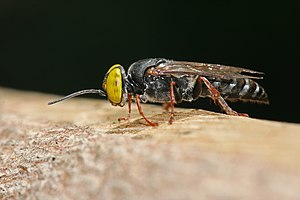Tachysphex
| Tachysphex | ||||||||||||
|---|---|---|---|---|---|---|---|---|---|---|---|---|

Tachysphex sp. in Dar es Salaam |
||||||||||||
| Systematics | ||||||||||||
|
||||||||||||
| Scientific name | ||||||||||||
| Tachysphex | ||||||||||||
| Kohl , 1883 |
Tachysphex is a species-rich genus of digger wasps (Spheciformes) from the Crabronidae family. 446 species are known worldwide; the genus is thus the most species-rich of the Larrini tribe. The Palearctic is home to around 138 species, 47 of which are found in Europe.
features
The species of the genus Tachysphex are between 4 and 18 millimeters long, the majority of the species are between 6 and 10 millimeters long. The digger wasps are black, their abdomen is partially red in some species, as are the legs. In contrast to the similar genus Tachytes , the pygidial field of the females and the seventh abdominal segment are hairless. It is particularly difficult to distinguish the completely black species from one another.
Way of life
The usually multicellular nests are created in sandy or cohesive soils, with preference for settling on flat surfaces. The females carry larger parts and stones away with their mandibles, while fine material is dug up with the tarsi of the front legs and pushed back out of the passage with the body. The passage lies mostly flat in the ground, the cells are created at a depth of only three to six centimeters. Depending on the species, the nest entrance is closed or remains open when absent. The brood is fed with locusts. Depending on the species, a specific family of locusts is preferred. The prey is brought into the nest with the belly side up either in flight or walking. Their antennae are grabbed with the mandibles , while the prey is also stabilized with the legs in flight. Eggs are laid on either the first or the last grasshopper, near the hips of the front legs. In the cell, the prey is placed with the belly side up and the head down. The anesthetized animals usually move their legs and antennae weakly.
Pupation takes place in a solid cocoon that is spun from silk overlaid with sticky sand. A number of parasitoids , such as gold wasps , spider ants , woolly hoops, and satellite flies, are known to infest the digger wasps. The adults are flower visitors. In the evening or when the weather is bad, the animals look for a cavity, and males with a tarsia crest also bury themselves.
Systematics
Tachysphex belongs to the tribe Larrini within the subfamily Crabroninae .
Species (Europe)
- Tachysphex adjunctus Kohl , 1885
- Tachysphex albocinctus ( Lucas , 1849)
- Tachysphex Blattivorus Gussakovskij , 1952
- Tachysphex brevipennis Mercet , 1909
- Tachysphex brullii F. Smith , 1833
- Tachysphex carli Beaumont , 1947
- Tachysphex consocius Kohl , 1892
- Tachysphex coriaceus A. Costa , 1867
- Tachysphex costae De Stefani , 1882
- Tachysphex ctenophorus Pulawski , 1971
- Tachysphex denisi Beaumont , 1936
- Tachysphex descendentis Mercet , 1909
- Tachysphex erythropus ( Spinola , 1839)
- Tachysphex euxinus Pulawski , 1958
- Tachysphex excelsus R. Turner , 1917
- Tachysphex ferrugineus Pulawski , 1971
- Tachysphex fugax Radoszkowski , 1877
- Tachysphex fulvicornis R. Turner , 1918
- Tachysphex fulvitarsis A. Costa , 1867
- Tachysphex gracilitarsis Morice , 1910
- Tachysphex graecus Kohl , 1883
- Tachysphex helveticus Kohl , 1885
- Tachysphex incertus Radoszkowski , 1877
- Tachysphex julliani Kohl , 1883
- Tachysphex latifrons Kohl , 1884
- Tachysphex lindbergi Beaumont , 1956
- Tachysphex mediterraneus cabbage , 1883
- Tachysphex minutus Nurse , 1909
- Tachysphex moczaryi Kohl , 1884
- Tachysphex nitidior Beaumont , 1940
- Tachysphex nitidissimus Beaumont , 1952
- Tachysphex nitidus ( Spinola , 1805)
- Tachysphex obscuripennis ( Schenck , 1857)
- Tachysphex obscurus Pulawski , 1971
- Tachysphex panzeri ( Vander Linden , 1829)
- Tachysphex persa Gussakovskij , 1933
- Tachysphex plicosus ( A. Costa , 1867)
- Tachysphex pompiliformis ( carapace , 1805)
- Tachysphex psammobius ( Kohl , 1880)
- Tachysphex pseudopanzeri Beaumont , 1955
- Tachysphex saundersi Mercet , 1909
- Tachysphex schmiedeknechti Kohl , 1883
- Tachysphex sordidus ( Dahlbom , 1845)
- Tachysphex subdentatus F. Morawitz , 1893
- Tachysphex tarsinus ( Lepeletier , 1845)
- Tachysphex tessellatus ( Dahlbom , 1845)
- Tachysphex unicolor ( Panzer , 1806)
supporting documents
Individual evidence
- ↑ Numbers of Sphecid Extant Species ( Memento of the original from July 1, 2010 in the Internet Archive ) Info: The archive link was inserted automatically and has not yet been checked. Please check the original and archive link according to the instructions and then remove this notice. in: Wojciech J. Pulawski: Catalog of Sphecidae sensu lato. California Academy of Sciences, November 27, 2009 version
- ↑ a b c d Manfred Blösch: The digger wasps in Germany: way of life, behavior, distribution . 1st edition. Goecke & Evers, 2000, ISBN 3-931374-26-2 , pp. 223 .
- ↑ Tachysphex. Fauna Europaea, accessed July 23, 2010 .
literature
- Manfred Blösch: The digger wasps in Germany: way of life, behavior, distribution . 1st edition. Goecke & Evers, 2000, ISBN 3-931374-26-2 .
